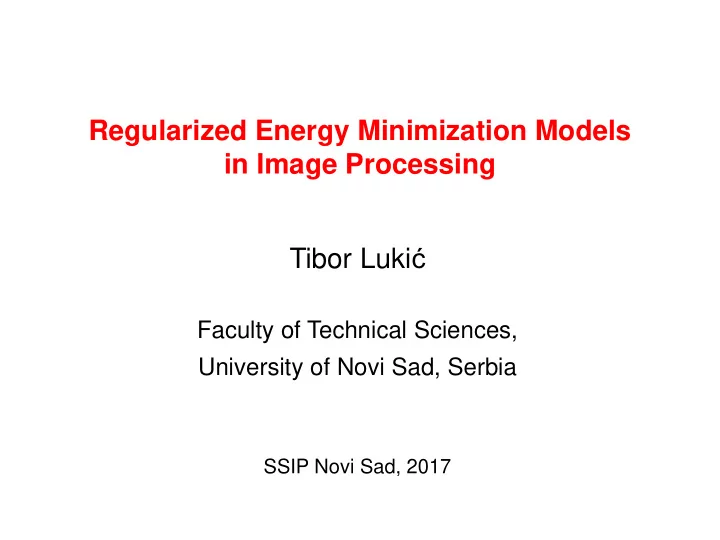

Regularized Energy Minimization Models in Image Processing Tibor Luki ć Faculty of Technical Sciences, University of Novi Sad, Serbia SSIP Novi Sad, 2017
OUTLINE ENERGY-MINIMIZATION METHODS REGULARIZED PROBLEMS IMAGE DENOISING DISCRETE TOMOGRAPHY DESCRIPTORS
ENERGY-MINIMIZATION METHODS Denoising example * Model design: * Minimization process
REGULARIZED ENERGY FUNCTION Regularized energy function regularization term data fitting term - balancing parameter, - linear operator - observed data Applications: denoising, deblurring, discrete tomography, classification, zooming, inpainting, stereo vision..
REGULARIZED ENERGY FUNCTION Quadratic function, convex, but often not strictly convex.
REGULARIZED ENERGY FUNCTION Example. Rudin et al. (1992) introduce the Total variation based regularization for denoising problem, where .
REGULARIZED ENERGY FUNCTION Discrete gradient
WHY WE USE THE GRADIENT? In continuous case, we can consider the directional derivative:
GRADIENT BASED OPTIMIZATION is a closed and convex set. Spectral Projected Gradient Optimization Algorithm (SPG) For a given arbitrary initial solution the algorithm converges if the following is satisfied: .
GRADIENT BASED OPTIMIZATION .
IMAGE DENOISING Noise clearly visible in an image from a digital camera. Wikipedia
IMAGE DENOISING Image noise is random (not present in the object imaged) variation of brightness or color information in images. Random variation in the number of photons reaching the surface of the image sensor at same exposure level may cause noise ( photon noise ). Incorrect lens adjustment or motion during the image acquisition may cause blur .
IMAGE DENOISING The degradation model is given by . Regularized energy-minimization model: Minimization has several challenges: large-scale problem, the objective function is non-differentiable at points where , and it is convex only when is convex.
POTENTIAL FUNCTIONS
POTENTIAL FUNCTIONS for low noise for high noise
IMAGE DENOISING Several algorithms have proposed: • Projection algorithm (PRO), Chambolle (2004), for TV only, • Primal-Dual Hybrid Gradient (PDHG), Zhu and Chan (2008), for TV only, • Fast Total Variation de-convolution (FTVd), Wang et al. (2008), for TV only, • Spectral Gradient Based Optimization, Lukic et al. (2011), • Elongation based image denoising model, Lukic and Zunic (2014).
IMAGE DENOISING . Signal to Noise Ratio (dB):
DISCRETE TOMOGRAPHY Tomography deals with the reconstruction of images, or slices of 3D volumes, from a number of projections obtained by penetrating waves through the considered object. Applications in radiology, industry, materials science etc. CT scanner
DISCRETE TOMOGRAPHY Tomography deals with the reconstruction of images from a number of projections. Reconstruction problem: , where the projection are given. matrix and vector
DISCRETE TOMOGRAPHY DT deals with reconstructions of images that contain a small number of gray levels from a number of projections: , . Main issue in DT: how to provide good quality reconstructions from as small number of projections as possible. DT reconstruction problem can be formulated as a constrained minimization problem: , where .
DISCRETE TOMOGRAPHY For binary tomography, Schüle et al. (2005) introduce the convex-concave regularization: where In general case: where is a multi-well potential function. The proposed energy, is differentiable and quadratic.
DISCRETE TOMOGRAPHY Construction of the multi-well potential function.
DISCRETE TOMOGRAPHY Phantom (original) images, N=256x256. 3 intensity levels,
DISCRETE TOMOGRAPHY ON TRIANGULAR GRID Reconstructions from 3 projections and y=2 6 projections. x-z=1
DISCRETE TOMOGRAPHY ON TRIANGULAR GRID The dense projection approach Unknowns: s - number of odd pixels l - number of even pixels System has a unique solution!
DISCRETE TOMOGRAPHY ON TRIANGULAR GRID [ ]
REGULARIZATION We always looking for new regularizations... SHAPE DECRIPTORS ARE POSSIBLE REGULARIZATIONS. The shape, as an object property, allows a wide spectrum of Numerical characterizations or measures.
SHAPE DESCRIPTORS Basic requirements : invariance with respect to translation, Rotation, and scaling transformations. The same numerical value should be assigned to all the shapes.
SHAPE DESCRIPTORS Shape measures
SHAPE DESCRIPTORS Most common requirements for shape measures are:
SHAPE DESCRIPTORS Geometric (area) moments of order p+q: The approximation is very simple to compute, and it is very accurate: [ ] Moments are very desirable operators in discrete space, because no infinitesimal process required, in opposite to gradient:
SHAPE DESCRIPTORS Hu moments (algebraic invariants) are also rotational invariant : Hu moments are translation, scaling and rotation invariant. Drawback: no clear “geometric” behavior.
SHAPE DESCRIPTORS Central moments are translation invariant : where is the centroid of S. Normalized moments are scaling invariant too: that is . Normalized moments are translation + scaling invariant.
SHAPE ORINETATION AS A REGULARIZATION The shape orientation is an angle alpha which satisfies the formula: where, Of course, shape orientation is translation invariant.
SHAPE ORINETATION AS A REGULARIZATION Binary images (shapes) and their orientations. Binary tomography energy model with orientation based regularization:
SHAPE ORINETATION AS A REGULARIZATION But why? • Recall • Horizontal and vertical projection
SHAPE ORINETATION AS A REGULARIZATION Experimental results:
SHAPE ORINETATION AS A REGULARIZATION more experimental results: Noise sensitivity:
SHAPE ELONGATION AS A REGULARIZATION Elongation (ellipticity) based image denoising.
SHAPE ELONGATION AS A REGULARIZATION Instead of gradient we use the elongation operator.
SHAPE ELONGATION AS A REGULARIZATION ELONG-D
LITERATURE
THANK YOU FOR YOUR ATTENTION!
Recommend
More recommend